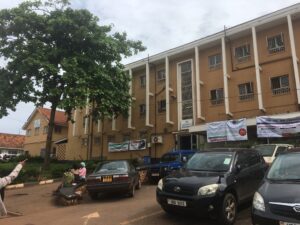Engaged Anthropology Grant: Catalina Villamil

We’re delighted to present another great addition to the Engaged Anthropology Grant blog series with a post from Catalina Villamil who had the opportunity last year to return to Uganda to share the results of her Dissertation Fieldwork Grant.
In 2015, I received a Wenner-Gren Dissertation Fieldwork Grant to study the evolution of head and neck anatomy in humans and our ancestors. One of the clearest adaptations in our ancestors is the adoption of bipedalism, and a large part of paleoanthropological research is focused on understanding when, how, and why bipedalism evolved. Oftentimes these questions must be answered from a limited number of fossil remains, and so biological anthropologists want to get as much information as possible from as many parts as possible. My research showed that there is little or no influence of bipedalism on the shape of the head or the underlying relationships between the head and the neck, which suggests many assumptions about locomotion from fossils may be incorrect or premature.

My project entailed the collection of data on hundreds of human skeletons from Europe and Africa, in order to sample human variation. As part of this work, I visited the Department of Anatomy at the Makerere University College of Health Sciences in Kampala, Uganda, where the Galloway Osteological Collection of recent East African human skeletons is housed. This collection is vitally important in biological anthropology, as collections of African skeletal material, and in particular recent material, are rare. Further, although Africa is home to a great deal of human variation, it is not well represented in biological anthropology or anatomical research. The academic community at Makerere was welcoming and deeply interested in promoting the use of this collection, but without access to the resources that make much of osteological research possible. As a result, I wanted to go back and share my results with them, as well as other resources that could be used by faculty and students to expand research using the collection. In 2019, I received the Engaged Anthropology Grant, which enabled me to visit Uganda again and share my results with the academic community there, and to provide a workshop on anatomical and osteological research methods.
I visited Kampala on the week of October 14, 2019 to coincide with World Anatomy Day, which is held worldwide on October 15. While there, I gave a public lecture on my research findings utilizing the Galloway Collection. Students and faculty from Makerere University, as well as from Kampala International University (KIU), attended the lecture, as did representatives of the Anatomical Society of Uganda. The next day, I also provided a methods workshop, Collecting and analyzing human osteological data, to the faculty and students at Makerere and KIU. In the workshop, I discussed osteological methods for aging and sexing, data collection standards and tools, and methods for analyzing morphological data. In addition, I provided the attendees manuals and other resources, as well as short tutorials on freely available software programs and comparative datasets that they can use to carry out data collection and analysis. With Wenner-Gren funding, I was able to bring specialized calipers that can be used for data collection on skeletal materials, to assist with the workshop discussion of standard measurements and tools. These tools were donated to the department at the end of the workshop. Dr. William Buwembo, chair of the department, and Dr. Ian Munabi hope Makerere students will use these tools and information to increase research use of the osteological collections and to improve representation of African variation in published research. As part of this workshop I also met with several graduate students who are doing research both at Makerere and KIU, and we discussed their methods and research questions, leading to some productive discussions on work that has already been done by biological anthropologists and how it relates to the work being done at these two universities.

In addition to the lecture and workshop, I met with faculty members and others with the hope of strengthening collaborations between Makerere and my own university and creating an ongoing academic relationship. Like many universities in the US, the Makerere College of Health Sciences faces growing class sizes but limited resources, especially for research. We hope that we will be able to identify funding opportunities that will benefit both institutions and that will fund the next generation of anatomy- and osteology-oriented researchers at Makerere. At the end of my weeklong visit, I also met with collections staff in charge of skeletal and paleontological materials at the Uganda National Museum. Museum curators would like to expand knowledge and use of the collections at the National Museum, as well as to facilitate student training and the creation of educational materials for the Ugandan public. We hope to develop an ongoing collaboration as well.